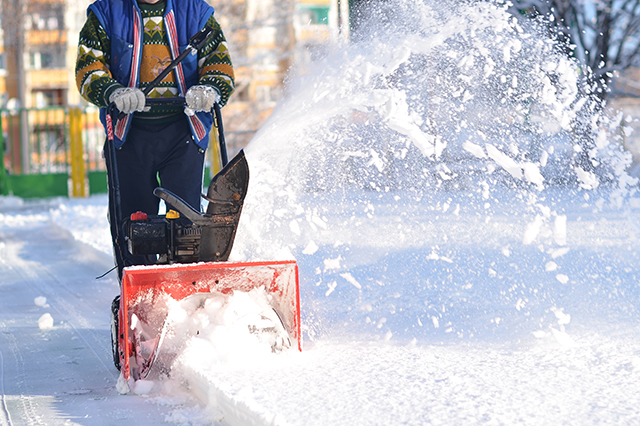More and more people are turning to a snow blower for their snow maintenance needs. Using a snow blower is fast, efficient and doesn’t require as much effort as shoveling, so it’s no wonder that this technology is being embraced by consumers. Whether you’ll be purchasing a new snow blower this winter, or you just want to take better care of your machine, this guide will give you a helpful overview.
The Benefits of an Electric Snow Blower
There are two main types of snow blowers: electric-powered and gas-powered. Electric snow blowers are meant for light snow removal. These are either plugged directly into an outlet with a cold weather extension cord or powered by a battery. These models are a lot lighter to carry than gas snow blowers, and are best for small properties where snow removal is minimal. Electric snow blowers are perfect for seniors and others who can’t carry larger models. They’re best for areas that don’t get a ton of snowfall, so if you plan on clearing out a foot of snow this winter, you might want to choose a different model.
The Benefits of a Gas Snow Blower
Single-Stage Gas Snow Blowers
Gas snow blowers are divided into three types: single-stage, dual-stage and three-stage. Single-stage blowers are ideal for moderate snow and can take care of most accumulations up to 8 inches. But make sure you don’t use a single-stage on gravel surfaces; since it touches the ground when throwing snow, it’ll shoot out bits of gravel on contact.
Dual-Stage Gas Snow Blowers
If you expect heavier snowfall or live on a large property, a dual-stage model is your best bet; these snow blowers are great for managing snowfall of a foot and higher. You can even use them to clear out ice and heavy, wet snow. If you have a large gravel or concrete driveway you need to clear, or live in area with high average snowfall, this kind of model is a great pick.
Invest in a more powerful model like this if you have a lot of hilly terrain to work with, as this is a lot tougher to manage than snow flat on the ground. And if you’re going to be making a lot of wide turns with your snow blower, you might want to look for a model with power steering.

Three-Stage Gas Snow Blowers
Finally, three-stage snow blowers are meant for the heaviest snow accumulations. Chances are you won’t need to invest in a three-stage model unless you work in commercial snow removal, or if your area is prone to extremely heavy winter storms. With each stage, the models become a little more expensive, so choose the snow blower you think you’ll need. Many electric snow blowers will do the trick if you have a small yard, so do some research before purchasing your machine and read about the recommended uses for each model.
Changing the Oil in Your Snow Blower
If you decide to purchase a gas snow blower, you need to remember to change the oil every so often. Make sure to read the instruction manual to see how much oil is recommended for your model, and be sure to double check for any leaks. If you’d rather not worry about replacing the oil and want easier maintenance, consider an electric snow blower.
Essential Snow Blower Maintenance
Aside from replacing the oil, there are a number of parts on your snow blower that will wear down over time and need to be inspected. It’s essential to check your shear pins, which connect the gear case to the auger, to note if they’re missing or broken. You should have a few spare sets of these lying around, just in case they break mid-season. When installing new shear pins, make sure you’re using exact replacements or it could cause damage to the machine.
You’ll also want to inspect your scraper bars and skid shoes; these will wear down as the winter season goes on, so they will need to be replaced as needed to keep the machine functioning properly. The belts are another area you want to keep a close eye on. If you see heavy wear and tear on one of the belts, remove it and replace with a new part, being sure to maintain the same placement.
Storing Your Snow Blower
It’s important to make sure you store your snow blower properly. Because you’ll use it so often in the winter, you might consider leaving it outside. However, you may have trouble starting it if it’s constantly exposed to frigid temperatures. Your best bet is to leave it in your garage where it won’t be too exposed to the elements.
Learn about homeowners and condo insurance from AAA.
Got a great snow blower maintenance tip? Leave it in our comment section.
15 Thoughts on “How to Choose the Best Snow Blower”
Leave A Comment
Comments are subject to moderation and may or may not be published at the editor’s discretion. Only comments that are relevant to the article and add value to the Your AAA community will be considered. Comments may be edited for clarity and length.














If you have a fuel shutoff valve, turn off the fuel and run the unit dry until it stops, that way your carburetor won’t get gummed up. Also, always use fuel stabilizer in the gas.
Always brush or scrape of accumulated snow. Then work the chute and all mechanical controls. Ice buildup will keep a machine from functioning when you next need it. At end of season add stable to gas. Start machine once warm turn off and change oil I use mobile 1. Remove as much gas from the tank as you can. Restart and allow to run until the machine stops.
Whether your snowblower rusts depends on what material your town spreads on icy/snowy roads. My 7-year-old snowblower has lots of corrosion from road salt that the town plows into my driveway. I am fighting it by grinding off the rust, adding rust-proof paint and several coats of car wax each spring after I give the snowblower a good washing. Start doing this when your snowblower is new and the body will last a lot longer.
Use treated fuel (ethanol) all the time. Also use high octane – makes for a VERY easy first start of the season. Don’t forget the other maintenance points and you’ll be ready to show them snowflakes who’s boss!!!
I have a 7 year old craftsman single stage blower and had the carburetor cleaned out because it would only run on 1/2 choke, put it back on and still not running properly, still need to keep it on 1/2 choke to run. Any ideas
Hi there!
Have you tried contacting your local hardware store or small-engine repair shop for advice? I bet they’d be able – and happy –
to help you.
Good luck!
Sounds like you have a vacuum air leak. Check that the carb. bolts are tight, hoses attached to carb are not cracked, hard or loose. Since you have to use a 1/2 choke condition, to much air is getting in, thus you need more fuel to compensate.
I recommend starting the snow blower once a month, during the off season, to keep it running well and keep the carburetor from becoming clogged. The previous season, I had to have a $150 service call to get it cleaned out and running. This year, it started like a charm. Just a tip to save some money and problems when that first snow hits.
Belts often need adjustment after a season or two – this can be very important – even though you may not notice anything strange. Also, don’t go for more than two seasons max before changing the oil and remember its different oil than lawnmower oil – Not SAE-30. Usually its 5W-30. Linkages underneath engine should be lubricated at least every 3 years. Lack of lubrication often causes the “gears” to misalign and disappear on you – like when reverse is missing or you put it into 1st and it starts going backwards. As mentioned by other folks, number one mistake most people make (myself included) is not draining gasoline or adding stabilizer after the season ends. Gasoline today should not sit more than two months. other wise it will start to take a toll on your carburetor. Fire your snowblower up and let it run for 5 minutes if you don’t want to drain it.
I would not leave the snowblower out in the weather. Better to clean it off a bit and bring it in. If you leave it out the heat from using it will melt the snow some and then it will refreeze especially in the chute and auger areas. When you start using it the next time this can put unnecessary strain on these areas. Taking five minutes to clean off the machine before bringing it into the garage will prevent a flood and it should dry quickly.
Treat your fuel with a stablizer and drain the system at the end of the season. Ethanol in todays fuel deteriorate very fast and clogs up your carburetor.
You won’t have to drain the gas tank for storage if you put a little fuel stabilizer in the gas tank.
Great information.
If you bring your snow blower covered with snow and ice into your above-freezing garage, the snow will melt off and make a flood in your garage. Also, water/road salt will rust your snowblower faster if warmed up. Leave it frozen until spring, then wash it off when you put the machine to bed.
I wouldn’t worry too much about a little melted snow from your snowblower. Your cars will leave far more melted snow. Even better, in the spring, seal your garage floor and never worry about dirt, snow, grease or anything else.
Also, salt does not care what temperature it is. It corrodes bare metal equally well regardless of temperature. Besides, unless you are living in the Arctic, temperatures will rise above freezing and that accumulated snow will melt, even if your snowblower is outside. It’s a good thing that all of the metal parts of the snowblower are painted for protection. If you are really worried about the salt, you’d rinse your snowblower after each use. But trust me and my 20+ year old snowblower that doesn’t have the tiniest bit of rust on it. Keep it out of the elements where it will last longer. Avoid using gas with ethanol. At the end of the season, make sure the gas is empty.